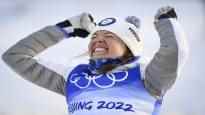Therese Johaug won her third medal at the Beijing Winter Olympics as she celebrated an overwhelming victory in Sunday’s 30-kilometer freestyle race. Kerttu Niskanen reached the bronze medal and grabbed his second medal at the Beijing Olympics.
Therese Johaug skied to an overwhelming victory in the final of the Beijing Olympic Skiing, a 30-kilometer freestyle joint start. Kerttu Niskanen saw an incredible ascent to the bronze, as he caught up with the medal stand for more than half a minute in the last few kilometers.
The competition became the show of Johaug, who skied the last Olympic competition, as the Norwegian started to break away from the top group already in the second round. He skied alone for the last 20 miles and won the race almost two minutes apart from the second-placed U.S. Jessie Diggins.
The gold medal was Johaug’s third at the Beijing Olympics: she also previously won the women’s 10km traditional race and combination race.
There was fierce competition for the bronze medal. Swedish Ebba Andersson was caught in a bronze position for a long time, but froze at the end. Kerttu Niskanen stretched to an incredible ascent in the last kilometer and climbed all the way to bronze. He still fought in the final straight for Sweden Jonna Sundlingia and the Russian Olympic Committee team Tatiana Sorinaa against, but held its place. Andersson was eighth in the end. Krista Pärmäkoski was the second best Finn and the tenth.
Conditions on the Zhangjiakou trails were again grueling, and strong winds haunted competitors from the start. The women’s race had been brought forward by 3.5 hours due to weather forecasts. The men’s race was shortened on Saturday, but the women skied 30 kilometers as planned.
This is how the competition progressed
Therese Johaug pulled the crowd from the start, and the crowd disbanded at an early stage. Johaug drew the first set of four skiers, and Pärmäkoski and Niskanen skied in the second group. Surprisingly, no Russian was in the top ten.
– Quite a lot of people have left too much traffic. Situations will change enormously, Sport’s expert Toni Roponen pointed out.
At six kilometers, Niskanen pulled the top chasing crew, which was 17.8 seconds behind. Pärmäkoski skied a bit after the second group, but reached the group when they arrived at the stadium.
Already in the second round, Johaug left alone to break away from the top group. At 10.4 miles, Johaug’s difference to second-placed Jessie Diggins was already sixteen seconds. The top four split to ski alone, as Ebba Andersson, who was third, was more than half a minute away and Delphine Claudel 49 seconds from the tip. The second group, where Niskanen and Pärmäkoski also skied, had been just over a minute away.
– Quite clear tactical instructions have been given to the Finns that they will not be drawn into the headwind. Rosie Brennan let’s do the work when skiing upwind and Kerttu Niskanen takes the lead when going downwind, Sport Sports Expert Jussi Piirainen pointed out.
By mid-Johaug had already escaped 25.7 seconds from Diggins and Andersson had been more than a minute away. The crew of Niskanen and Pärmäkoski were one and a half minutes from the top, but reached Andersson.
However, the Swedish skier got a new impetus, and the Pärmäkoski and Niskanen team did not find any leaders in the bronze medal battle before the last ten. Andersson managed to widen the gap to the second team again in half a minute.
– Clearly there were no desire to pull, and no skiers so strong. Andersson also picked up, he had a harder moment, but skiing now looked better. The chase group went a little loose, no one wanted to waste too much of their own strength. When Andersson was close, an attempt was made to catch him, but now there is cross-country skiing again. This pace is by no means enough for a medal battle, Piirainen comments.
Johaug had already escaped at 21.2km a minute and eight seconds from Diggins. Andersson’s difference to the top was more than two minutes. However, the group pursuing the bronze spot was well over half a minute away from Andersson.
In Pärmäkoski, when he left for the last lap, the rod broke off, and he was a little short of the group that chased Andersson. The difference between Pärmäkoski and the bronze place at the beginning of the last round was more than 40 seconds.
Four kilometers before the goal, Johaug’s difference to Diggins was already 40 minutes. Delphine Claudel, who led the second group, had a difference of 26 seconds to Andersson, who took the bronze place.
In the end, an incredible battle was won for the bronze medal, which was finally won by Niskanen. During the last kilometers, Niskanen caught Andersson for half a minute, passed Andersson first when he entered the stadium, and still followed Tatiana Sorina and Jonna Sundling. Niskanen finally beat Sundling by two seconds and was just over two and a half minutes behind Johaug.
Tired Andersson finally dropped to eighth. Pärmäkoski was tenth (+3.41), Anne Kyllönen 20: s (+6.47) and Johanna Matintalo 23: s (+7.07).
